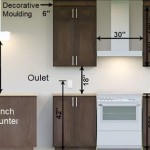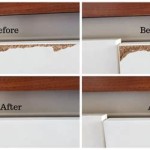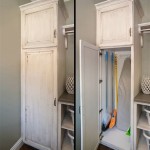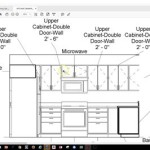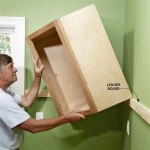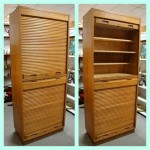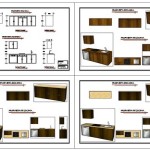Can I Use Kitchen Cabinets In Garage? A Comprehensive Guide
The question of repurposing kitchen cabinets for garage storage is a common one among homeowners seeking cost-effective and practical organization solutions. While seemingly straightforward, the suitability of kitchen cabinets for garage use depends on several factors, encompassing material durability, environmental considerations, load-bearing capacity, and the intended storage needs. A thorough evaluation of these aspects is crucial before embarking on such a project.
Durability and Material Considerations
Kitchen cabinets are typically designed for the relatively stable environment of an interior space. Garage environments, however, often present a harsher set of conditions, including fluctuating temperatures, humidity, and potential exposure to moisture, chemicals, and pests. Standard kitchen cabinets, particularly those constructed from particleboard or medium-density fiberboard (MDF), may be vulnerable to warping, swelling, and delamination under prolonged exposure to these elements. Solid wood cabinets offer a more durable alternative, but even they can be susceptible to moisture damage if not properly sealed and maintained.
The choice of material should be carefully considered based on the specific garage environment. If the garage is prone to dampness, cabinets made from moisture-resistant materials, such as marine-grade plywood or certain types of plastic, are preferable. Metal cabinets offer excellent durability and resistance to pests and chemicals, but they can be more expensive and may require specialized tools for installation. Cabinets with a durable finish, such as a powder-coated or polyurethane coating, provide added protection against scratches, stains, and corrosion.
The construction quality of the cabinets is also a critical factor. Look for cabinets with solid joints, sturdy hardware, and reinforced shelves. Cabinets designed for heavier loads, such as those with full-extension drawers and adjustable shelves, will be better suited for storing tools, equipment, and other garage items.
The location within the garage also plays a role. Cabinets placed near potential sources of moisture, such as a leaky faucet or a car parked indoors during wet weather, will require greater protection than those installed in drier areas. Similarly, cabinets located near a workbench or other work area are more likely to be exposed to chemicals and spills, necessitating a more durable and chemical-resistant finish.
Environmental Factors and Potential Risks
The garage environment is significantly different from the kitchen environment, and this difference poses challenges for using kitchen cabinets intended for indoor use. Garages typically experience wider temperature swings, higher humidity levels, and greater exposure to dust, dirt, and chemicals. These factors can degrade the materials and finishes of kitchen cabinets, leading to premature failure and reduced lifespan.
Humidity is a major concern. Excessive moisture can cause particleboard and MDF cabinets to swell and warp, compromising their structural integrity. Even solid wood cabinets can be affected by humidity, leading to cracking, splitting, and fungal growth. Proper ventilation and dehumidification can help mitigate these risks, but they may not be sufficient in particularly damp climates.
Temperature fluctuations can also contribute to cabinet damage. Rapid changes in temperature can cause materials to expand and contract, leading to stress cracks and joint separation. Extreme heat can soften adhesives and coatings, while extreme cold can make materials brittle and prone to breakage.
Exposure to chemicals, such as automotive fluids, cleaning solvents, and pesticides, poses another risk. Many common household chemicals can damage the finishes of kitchen cabinets, causing discoloration, staining, and etching. Cabinet materials may also absorb these chemicals, leading to unpleasant odors and potential health hazards.
Pest infestations are also a concern in garages. Insects and rodents can damage cabinets by chewing on the wood, nesting inside, and contaminating stored items. Regular inspection and pest control measures are essential to protect cabinets from damage.
Load-Bearing Capacity and Intended Use
The load-bearing capacity of kitchen cabinets is another crucial consideration when repurposing them for garage storage. Kitchen cabinets are typically designed to hold relatively light items, such as dishes, cookware, and food supplies. Garages, on the other hand, often require storage for heavier items, such as tools, equipment, automotive parts, and sporting goods. Exceeding the load-bearing capacity of kitchen cabinets can lead to shelf failure, drawer collapse, and even structural damage to the entire cabinet unit.
Before using kitchen cabinets in the garage, it is essential to assess their load-bearing capacity. This information is usually available from the manufacturer's specifications or can be estimated based on the cabinet's construction and materials. Cabinets made from solid wood or heavy-duty plywood are generally capable of supporting heavier loads than those made from particleboard or MDF.
The intended use of the cabinets should also be carefully considered. If the cabinets will be used to store lightweight items, such as gardening tools, cleaning supplies, or recreational equipment, standard kitchen cabinets may be sufficient. However, if the cabinets will be used to store heavier items, such as power tools, automotive parts, or metal hardware, reinforced cabinets with a higher load-bearing capacity are necessary.
Shelf supports are a critical factor in determining the load-bearing capacity of a cabinet. Shelves supported by metal brackets or adjustable shelf pins are generally stronger than those supported by plastic or wooden pegs. Consider reinforcing the shelf supports with additional brackets or supports to increase the load-bearing capacity.
When storing heavy items, distribute the weight evenly across the shelves to prevent excessive stress on any one point. Avoid placing heavy items near the edges of the shelves, as this can increase the risk of sagging or collapse. Consider using drawers for smaller, heavier items to distribute the weight more evenly.
For very heavy items, such as engine blocks or large power tools, consider using specialized garage storage solutions, such as heavy-duty shelving units or tool chests. These solutions are designed to withstand the rigors of garage use and provide ample support for heavy loads. Attaching the cabinets securely to the wall studs is also crucial to prevent tipping or collapsing, especially when storing heavy items.
Furthermore, the placement of the items within the cabinets can impact stability. Storing heavier items at the bottom of a cabinet and progressively lighter items on upper shelves creates a lower center of gravity. This configuration significantly reduces the risk of the cabinet tipping, especially important if the cabinet is not securely attached to the wall or floor. Proper weight distribution is a vital safety consideration when repurposing kitchen cabinets for garage use.
In summary, while repurposing kitchen cabinets for garage storage can be a viable option, a thorough assessment of the material durability, environmental factors, and load-bearing capacity is essential. Carefully consider the specific conditions of the garage environment, the intended use of the cabinets, and the weight of the items to be stored. Taking these factors into account will help ensure that the repurposed cabinets provide safe, effective, and long-lasting storage solutions.

Garage Cabinets Why You Should Avoid These 5 Types

Garage Cabinets Why You Should Avoid These 5 Types

Using Old Kitchen Cabinets In The Garage Is Alwasy A Good Idea Kingman Az Homes Corner Storage Shelves

What To Do With Old Kitchen Cabinets

Custom Garage Cabinets

Garage Storage Solutions Creative Edge Cabinets And Woodworking

Diy Garage Cabinets And Miter Saw Station Jenna Sue Design

Old Kitchen Cabinets Were Used To Make Garage Work

House Crashing Classic Natural With A Twist Young Love Kitchen Cabinets In Garage Makeover Old

Home Organization With Spring Cleaning Give Garage A Makeover Nj Com
Related Posts

